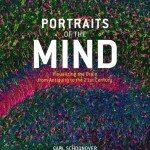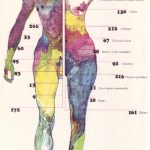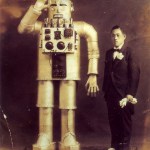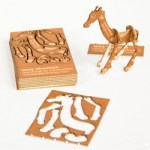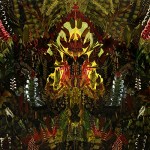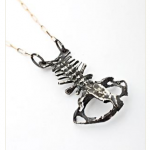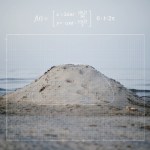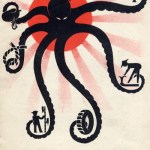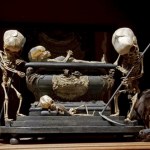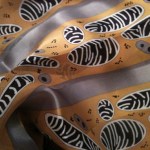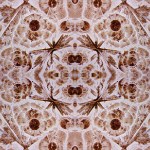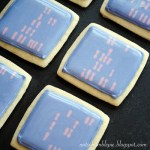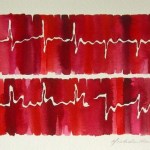
Reader Miles suggested Danny Cooke's graceful documentary about ornamental glass & sign artist David A. Smith, who uses traditional techniques like gilding, silvering, and etching to create ornate glass signs and windows with aesthetics from Victorian to Art Nouveau. Time-lapse sequences offer a surreal glimpse of Smith dexterously floating giant panels of glass around his studio, gently pressing them against grinders to carve the distinctive beveled patterns and fonts so familiar from vintage pubs or storefronts.
David A Smith - Sign Artist from Danny Cooke on Vimeo.
Particularly if…
What do you get when you ask Harvard physicist Lisa Randall to curate an art show? A Los Angeles gallery found out, and Wired has the story. My favorite quote:
I asked Mays whether the artists gained an appreciation for physics. "Oh god, yes!" he said. "I've seen them carrying books around about different scientific theories."
No! Not artists with books of scientific theories! The world is upside-down!
Coverage of the Measure for Measure exhibition is here - it sadly closed last weekend, but there are photos online, and I tracked down a few of the sciart contributors, Meeson Pae Yang (with an…
This, this and this all came close, but in the end, it took a book: a yummy new neuroscience, history of science, beauty of science, wow-brains-are-beautiful book.
The other day I heard about something that I just HAD to blog, hiatus/retirement be damned! Portraits of the Mind: Visualizing the Brain from Antiquity to the 21st Century, a new book by neurobiology PhD candidate Carl Schoonover, is coming out in a few weeks, and I'm lucky enough to have a preview copy sitting here before me.
This book encapsulates my original vision for BioE - a narrative that brings science history together…
In the New York Times, a quick article on a study in the journal Neurosurgery by two Johns Hopkins professors. The abstract argues that Michaelangelo
concealed another neuronanatomic structure in the final panel of this series, the Separation of Light From Darkness, specifically a ventral view of the brainstem. The Separation of Light From Darkness is an important panel in the Sistine Chapel iconography because it depicts the beginning of Creation and is located directly above the altar. We propose that Michelangelo, a deeply religious man and an accomplished anatomist, intended to enhance…
Don't be downhearted! Try some of these blogs:
A Journey Round My Skull
Makezine
SPGRA via NOTCOT
Coilhouse
Street Anatomy
Urban Omnibus
Daily Art Muse
Wouldn't You Like To See Something Strange?
Bottled Monsters
Everything is ephemeral - including bioephemera.
As of today, May 31, I'm going on hiatus for at least this summer - and probably longer. While I've met many wonderful fellow bloggers and faithful readers through the blog, keeping BioE going has become a significant investment of time that I just don't have. Since I started blogging, there's been an explosion in the number of blogs covering crossover sciart topics, like Morbid Anatomy, where I found the delicious image above. So I just don't feel BioE is strictly needed anymore - if it ever was. And I need to refocus on work, life, and art…
So cute, so bioephemeral: designer Wes Thomas created a laser-cut business card that snaps out to assemble a little giraffe. He's also done a gorilla.
Via Notcot.
The God Particle, 2008
Andy Harper does amazing work with oils: fantastic gardenscapes populated with unanticipated plants. Many of his works incorporate dramatic symmetry, reminiscent of a Rorschach blot or the patters on a flowerhead.
Half Devil, Half Buccaneer
Read an interview with Andy Harper at failedrockstar.
Here's a big time want: a sterling silver necklace cast from a frog spine and skull, by Elizabeth Knight. Wow. You can find it at Catbird!
While you're there, check out Knight's spin on pearl earrings (the pearls are held by skeletal frog hands!), the 14K paired ant necklace by Jezebel, which I like even better than the skeleton (but it's way more expensive) and Cloven Hoof's Cleopatra jewel beetle necklace. Yes, they're all pretty pricey, but their brass monocle necklace is a sexy-naturalist (or librarian) option for only $22.
Via the catbird blog - highly bookmarkable for all…
Wired published a gallery a few months back featuring the art of Nikki Graziano, a math and photography student at Rochester Institute of Technology, who combines photos with equations. Her Found Functions series is awesome - I love the way she spots functions and patterns in nature.
I recently stumbled across an interesting post (don't ask how I got there; how do you ever end up anywhere on the Web?) about how the octopus has been used as a propaganda symbol, from WW2 to Big Oil, to represent the terrifying Other. Fascinating stuff - read more here for starters, and here is an entire blog on the topic.
Joanna Ebenstein of Morbid Anatomy has just unveiled a new website, the Secret Museum, to house her "exhibition of photographs exploring the poetics of hidden, untouched and curious collections from around the world." So if you can't make it to her show in NYC (through June 6), you can browse her virtual exhibition of photos - like the eerie fetal skeleton tableau above (from Paris, circa 17th century).
So I had the pleasure of meeting the awesome Dr. Isis a few weeks ago. It turns out she is even more awesome in person than she is in pseudonymity. And she brought me a fabulous thing: a scarf from A Slice of Life Scarves. Creator Eve Reaven, a Bay Area cell biologist, "has continuously marveled at the intricacy and beauty of the natural patterns found inside cells. She shares what she has seen with others through designs for scarves and other textiles. In the current selection, she captures the essence of structures related to cell movement, cell traffic, energy and performance. Many of the…
"Fossil geometry" (detail)
Based on Eschschottzia Californica seeds collected by Mr W Reeves, April 1864.
From the collection of the Royal Microscopic Society.
UK sci-artist Heather Barnett has created a line of wallpapers using micrographs of cells, crystals, seeds, nanofibers, etc. They'd be particularly striking in a loft or other industrially inspired space - including a lab or a clinic waiting room. Come on, PIs, you can squeeze a wallpaper budget in your next grant application, can't you?
"Fossil geometry" (repeat)
Check out more of Barnett's biological wallpapers below the fold…
Lately Ms. Humble of Not So Humble Pie, "your typical nerdy biological anthropologist turned stay at home mom and baker of sometimes strange goodies," has cornered the market on science cookies. Check out her beautiful gel electrophoresis cookies (above): they are amazingly convincing AND ethidium bromide free (thank goodness). She's also made drosophila melanogaster cookies, zebrafish cookies, circuit board cookies:
wii-mote and Six axis controller cookies (not science, but come on, gamers and scientists have a high overlap), and blood cell cookies. Check out this educational video using…
DC area artist Michele Banks works with wet-in-wet watercolor to create abstract paintings of biological subjects - lots of cells, mitotic spindles, etc. You can see more of her work at her Makers Market shop (under the nom d'art Artologica), or at the SoWeBohemian Festival in Baltimore this weekend.
This is what I miss out on by not reading the physical copy of the New York Times: ads! I recently picked up a copy of the Times science section and saw an ad for these wonderful vintage patent office models from the 1900s.
As if they're not steampunky enough, each one comes with a little yellowed, handwritten, calligraphic tag that I'm dying to read because I am convinced it must contain cryptic clues to some sort of awesome Neil Stephenson-style mystery. Right??
Susan Silas takes photos of fallen birds - and they're oddly touching. It's very strange how songbirds remain graceful, even when broken and half-decayed. . .
My friend Shana mentioned this one to me: it's an LED sculpture that opens at night and folds closed during the day, like a light-sensitive flower. The creator, Wendy Legro, says: "The sun is our natural light source. Our homes are filled with artificial light replacing it, undeliberately disrupting our biological clock. This product works autonomously with a light sensor. During the day, mechanical flowers are closed enabling sunlight to come in. When sun sets, the flowers open and start to emit light. In this way, awareness for a beautiful phenomenon will be brought back."
I'm not usually…
